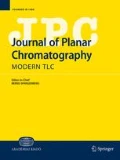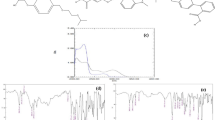Abstract
Duloxetine hydrochloride is an anti-depressant drug, while 1-naphthol is one of its hepatotoxic impurities. So, there was an urgent need to do simultaneous analysis for both the drug and its toxic impurity. Therefore, a validated high-performance thin-layer chromatography (HPTLC) method was established for the simultaneous separation and quantification of duloxetine hydrochloride and 1-naphthol in their binary mixture and pharmaceutical formulation. The utilized developing system consisted of a mixture of chloroform–ethyl acetate–benzene–33% ammonia solution (6:3:1:0.1, v/v). Densitometric scanning was used to detect the separated peaks at 233 nm using an ultraviolet detector. The validation of the estimated method was performed according to the International Conference on Harmonization guidelines. The results indicated that it can be used for the quality control analysis of the proposed mixture. The developed method showed advantages over the previously published TLC methods of having higher sensitivity and allowing the determination of duloxetine hydrochloride with and in the presence of its toxic impurity 1-naphthol.



Similar content being viewed by others
Abbreviations
- DUL:
-
Duloxetine hydrochloride
- HPTLC:
-
High-performance thin-layer chromatography
- ICH:
-
International Conference on Harmonization
- LOD:
-
Limit of detection
- LOQ:
-
Limit of quantification
- UV:
-
Ultraviolet
- %RSD :
-
Percent relative standard deviation
References
British Pharmacopoeia (2013) Her Majesty’s office, London
(2012) Martindale, The complete drug reference. Pharmaceutical Press, London
D’arcy Doherty M, Cohen GM, Smith MT (1984) Mechanisms of toxic injury to isolated hepatocytes by l-naphthol. Biochem Pharmacol 33(4):543–549
Tilak KS, Mohanaranga Rao D, Priyamvada Devi A, Murty AS (1981) Toxicity of carbaryl and 1-naphthol to four species of freshwater fish. J Biosci 3(4):457–461
Yunoos M, Gowri Sankar D, Pragati Kumar B, Hameed S, Hussain A (2009) Simple UV spectrophotometric determination of duloxetine hydrochloride in bulk and in pharmaceutical formulations. E-J Chem 7(3):785–788
Kamila MM, Mondal N, Ghosh LK (2007) A validated UV spectrophotometric method for determination of duloxetine hydrochloride. Pharmazie 62:414–415
Shahnawaz S, Siddiqui AW, Masroor MT, Arora V (2011) Stability-indicating HPTLC method for determination of duloxetine hydrochloride in bulk drug and tablet formulation. Chromatogr Res Int 2011:Article ID 404189
Chhalotiya UK, Bhatt KK, Shah DA, Baldania SL (2010) Development and validation of a stability-indicating RP-HPLC method for duloxetine hydrochloride in its bulk and tablet dosage form. Sci Pharm 78:857–868
Sinha VR, Anamika KR, Bhinge JR (2009) Stress degradation studies on duloxetine hydrochloride and development of an RP-HPLC method for its determination in capsule formulation. J Chromatogr Sci 47:589–593
Bhimanadhuni CN, Garikapati DR, Srinivas C (2012) Development and validation of RP-HPLC method for determination of duloxetine hydrochloride in bulk and dosage form. Int Curr Pharm J 1(5):98–102
Ammar RA, Otaif H, Al-Warthan A (2012) Quantitative determination of duloxetine hydrochloride in pharmaceuticals and urine using prepared ion selective membrane electrode. Int J Electrochem Sci 7:4369–4380
Raman NVVSS, Harikrishna KA, Prasad AVSS, Reddy KR, Ramakrishna K (2010) Determination of duloxetine hydrochloride in the presence of process and degradation impurities by a validated stability-indicating RP-LC method. J Pharm Biomed Anal 51:994–997
Kumar N, Sangeetha D, Vaghela D, Reddy PS, Raghav A (2012) Development and validation of a stability indicating RP-LC method for the estimation of process related impurities and degradation products of duloxetine hydrochloride and phthalic acid in duloxetine hydrochloride delayed release capsules. J Liq Chromatogr Relat Technol 35(7):867–881
Laha TK, Mishra G, Sen S (2012) A validated stability indicating reversed phase high performance liquid chromatographic method of duloxetine and characterization of its degradation products through retro-synthesis. Open Access Sci Rep 1(6):1–6. https://doi.org/10.4172/scientificreports.308
Anwar BH, Abdelhamid NS, Naguib IA (2019) A comparative chemometric study for quantitative determination of duloxetine hydrochloride in the presence of its toxic impurity 1-naphthol. Curr Pharm Anal 15. https://doi.org/10.2174/1573412915666190709093612
Naguib IA, Abdelhamid NS, Anwar BH, Magdy MA (2020) Three spectrophotometric methods for quantitative analysis of duloxetine in presence of its toxic impurity: 1-naphthol. J AOAC Int. https://doi.org/10.1093/jaoacint/qsz032
Wingert NR, Barth AB, Gomes B, Shapoval EES, Steppe M (2011) Quantitative analysis of duloxetine and 1-naphthol by capillary micellar electrokinetic chromatography. Curr Anal Chem 7(3):184–193
Ali NW, Zaazaa HA, Abdelkawy M, Magdy MA (2012) Simultaneous HPTLC and RP-HPLC methods for determination of bumadizone in the presence of its alkaline-induced degradation product. Biomed Chromatogr 26:1143–1149
Ali NW, Zaazaa HA, Abdelkawy M, Magdy MA (2011) Simultaneous determination of paracetamol and diphenhydramine hydrochloride in presence of paracetamol degradation product. Pharm Anal Acta 2011(2):140
Abdelwahab NS, Fared NF, Elagawany M, Abdelmomen EH (2017) Different spectrophotometric and chromatographic methods for determination of mepivacaine and its toxic impurity. J AOAC Int 100(5):1–8
Abdelwahab NS, Elshemy HAH, Farid NF (2018) Determination of flutamide and two major metabolites using HPLC–DAD and HPTLC methods. Chem Cent J 12(4):1–15
Abdelwahab NS, Farid NF (2014) Validated HPLC-DAD method for stability study of sulbutiamine HCl. RSC Adv 2014(4):30523–30529
Farid NF, Abdelwahab NS (2016) Stability-indicating HPTLC method for studying stress degradation behavior of sulbutiamine HCl. J Chromatogr Sci 2016:1–9
Farid NF, Abdelaleem EA (2016) HPTLC method for the determination of paracetamol, pseudoephedrine and loratidine in tablets and human plasma. J Chromatogr Sci 2016:1–6
ICH Q1A(R2) (2003) Harmonised tripartite guideline, stability testing of new drug substances and products. Geneva
Srivastava MM (2011) High-performance thin-layer chromatography (HPTLC). Springer, Heidelberg Dordecht, London
Author information
Authors and Affiliations
Corresponding author
Rights and permissions
About this article
Cite this article
Abdelhamid, N.S., Naguib, I.A., Anwar, B.H. et al. A validated HPTLC method for the quantitative determination of duloxetine hydrochloride and 1-naphthol in bulk and pharmaceutical formulation. JPC-J Planar Chromat 33, 391–396 (2020). https://doi.org/10.1007/s00764-020-00045-w
Received:
Accepted:
Published:
Issue Date:
DOI: https://doi.org/10.1007/s00764-020-00045-w




